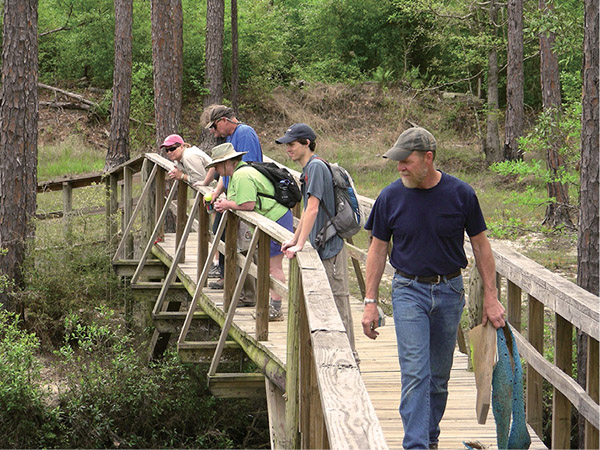
Hikers take time to enjoy the view along the spillway at Little River State Forest.
South Region
Geographically speaking, the South region of Alabama does not differ greatly from the Gulf Coast region. The hills are a bit higher, at times around 300 feet above sea level, but overall the region is flat coastal plain.
The main distinguishing features of this region are the rivers, lots of rivers! Take a look at the state seal and you will see what I mean. It is here where hundreds of rivers, creeks, and brooks all converge as they head to the Gulf of Mexico, making this a rich and fertile land.
One of the highlights of the region is Conecuh National Forest, renowned for its towering longleaf pines, crystal-blue spring lakes, and cypress ponds. It is also known for the 20-mile-long Conecuh Trail (see Honorable Mentions), an easy weekend hike along ponds and lakes and through dogwood, holly, magnolia, cypress, and, of course, longleaf forests. Here you will find three excellent day hikes that will take you to see these features without hiking the entire 20 miles.

Hikers take time to enjoy the view along the spillway at Little River State Forest.
As with the Gulf Coast region, the weather in the South is subtropical, and late summer heat and humidity can make outdoor activities impossible at times. If you’re hiking the region during this time, carry plenty of water and, of course, insect repellent. Much of the hiking in this region is around swamps and marshes, so expect mosquitoes. Also like the Gulf Coast region, close proximity to the Gulf of Mexico means that the warm, moist Gulf air can produce brief but very heavy rainfall unexpectedly.
As mentioned in the Gulf Coast introduction, 2004–5 was one of the worst hurricane seasons on record for south Alabama. Several trails in the region were severely damaged but have been cleared and are safe once again for public use. Remember to keep track of the tropics during hurricane season (generally June through November) before heading out.
In the spring the temperature moderates from the mid-60s to low 70s. The hot, humid summer gives way to great hiking weather from fall through winter. It does get a bit colder in this region than in the Gulf Coast, with temperatures averaging in the 40s in January. Cold snaps of below 30 degrees are more frequent here than in the Gulf Coast region.